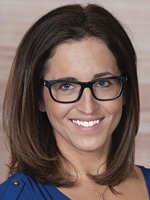November 2022—What labs want and need from their lab information systems and what the missing pieces are in interoperability are what pathologists and LIS company reps talked to CAP TODAY publisher Bob McGonnagle about when they met online Sept. 12.
“The biggest challenge is with device integration” in molecular testing, said J. Mark Tuthill, MD, of Henry Ford Health System. “We have million-dollar instruments and we’re still programming runs manually. We don’t have HL7 order feeds. We don’t have the ability to get result feeds outbound from those devices.”
In microbiology, too, there’s “a tremendous amount of information and little integration,” he said. For more, read on. CAP TODAY’s laboratory information systems product guide begins here.
Jonathon Northover, one of the drivers as we come out of the pandemic is consolidation. What’s top of mind for your customers and potential customers in what they’re looking for from CompuGroup Medical?
Jonathon Northover, vice president of product management, CompuGroup Medical: Number one is offering direct-to-consumer diagnostics, from test kits that the laboratory is responsible for sending to the customers of physicians, to services where someone collects the specimen professionally in the home, to setting up patient service centers for collection. Independent reference laboratories need an end-to-end solution—one that enables patients to order those tests and also provides integration with physician approvals when needed, depending on the type of test or panel or the state they’re in. There’s a lot of growth around patient portals—ordering and receiving results and interacting with the physician.
The second is refactoring PCR instruments to do microbiology testing. COVID testing volumes meant a lot of investment in those instruments. Now that COVID testing has dropped, they want to reuse their PCR instruments to maximize a return on that investment.
Suren Avunjian, can you answer the same question?
Suren Avunjian, founder and chief executive officer, LigoLab Information Systems: A lot of laboratories that were able to scale their volumes during COVID and had the cash flow are now acquiring more laboratories, scaling to multiple states, and repurposing their PCR machines to be able to run a larger variety of molecular testing. A lot of this is applied to and prepared for consumer testing. With the consumer portal, they’re able to attract direct-to-consumer and direct-to-organizational testing. We’re seeing volume starting to pick up on that front. What’s next is the ability for the patients to better understand their reports and be able to have a remote coaching session right out of the patient portal.

Modleski
Matt Modleski, are you seeing similar trends with your customers at Orchard?
Matt Modleski, executive vice president of corporate/business development, Orchard Software: We are. It brings to mind the question about the reimbursement for direct-to-consumer testing and how it fits with a physician office laboratory that wants that revenue. Once the consumer does the testing and insurance pays for it, if it does, how does the second test the doctor wants to order in the office or in their own laboratory get paid, or does it not get paid? It’s an interesting trend we’ll continue to watch.
We thought the pandemic was going to accelerate the adoption of molecular testing across a variety of areas, so we added a molecular business and integrated it with our solution. The question is how fast people can adapt their business model and make it a successful part of their business.
Dayna Carlin, I hear increasingly that a lot of what we call traditional clinical laboratory tests are being performed in pathology departments or in freestanding pathology centers. Is that trend continuing as you see it at NovoPath? And is this brought on by the complexity of cases that pathologists are dealing with today, where they need surgical, molecular, and some clinical pathology results all in the record?
Dayna Carlin, marketing director, NovoPath: Yes, this is a trend we are seeing. At NovoPath we call this segment of the market independent reference labs. We are talking to pathologists daily and hearing how they are looking to escape the hardships of operating in a pathology lab in big health care systems by opening their own independent practices. So it’s an interesting time because we’re seeing a lot of smaller labs forming but also a lot of consolidation. There are several larger labs in this space that have not been acquired by the big players, like the Quests of the world, and those larger labs are instead acquiring small to midsize reference labs. It’s an interesting time.
To your second question, the need to have anatomic and molecular under one house is being driven by the physicians. They already have a lot on their plates and consolidating the number of labs they leverage makes it easier for clinics to operate.
Michael Becich, what are you seeing around the needs that your clinical colleagues have for reporting? What is top of mind for you in terms of improving the IT offering?
Michael J. Becich, MD, PhD, associate vice chancellor for informatics for the health sciences; distinguished university professor and chair, Department of Biomedical Informatics, and interim co-director, Pittsburgh Supercomputing Center, University of Pittsburgh School of Medicine: In the mainstream right now is molecular testing. The lack of deep integration of that testing plus the myriad outsourced molecular tests remains a problem for pathologists in terms of communications to clinicians for decision-making.
The key is to make genomic data flow freely from laboratories doing the testing and the health systems managing the patients. Plus, if we’re going to do precision medicine or oncology in the future, we have to be prepared to keep DNA available on patients as a data mining resource and follow that DNA journey as the patient is tested for transplantation, immune therapies, oncology, or chronic diseases. It is a serious gap in the way pathology is coordinated, not only in large academic meccas but into community practice. In fact, some of the best innovations are in for-profit DNA testing laboratories where they’re realizing this is a way to distinguish themselves and add tremendous value to the patient journey.
Carol Ross of Clinisys, is this in sync with what you’re seeing and trying to do in product management and development?
Carol Ross, MBA, director of product management, Clinisys: Yes, it is. We’re hearing from our customers a lot about molecular and understanding the integration of the testing but not much about direct to consumer.

Webb
Lee Webb of Clinisys, can you comment on the pathology element?
Lee Webb, global product line manager, clinical lab products, Clinisys: As Dr. Becich said, we’re seeing a need for integrated reporting, especially in the anatomic pathology space but not unique to AP, to be able to look at data from different sources, including molecular, images, image analysis data, and bring it together into a centralized reporting mechanism. That includes data from the clinical laboratory as well.
I was just at a conference on cancer biomarkers, and one of the chief concerns from pathologists, reference lab executives, pharma folks, everyone, was how do we get a complete report on a patient into a patient record without creating confusion for the clinician. They said also they have to deal with PDF reports that get put into the record but can’t be edited or integrated with anything. Diana Richard, how are you grappling with that problem at Xifin?
Diana Richard, senior director of pathology and strategic development, Xifin: We’ve tried to build flexibility around our system and Web services so we can return information into either the institution’s own EMR or patient or client portals. If a client has its own patient portal and wants us to funnel information into that versus using the Xifin portal, we have that capability. If the client doesn’t have its own patient portal, we are able to produce test results on our patient portal. A lot of that is driven by application programming interfaces and being able to leverage that technology for this bidirectional format of communication.

Richard
There’s a greater need to consolidate patient records into a single platform, and there are several iterations of that. We have our VisualStrata, which is our clinical data management utility platform. The challenge is, who owns it? The hospital? The pathology group? How do you get the oncologist or radiologist to be willing to share the information? There has to be an agreement and understanding among the specialties in order to make the data aggregation valuable to the hospital for that patient as a whole. We try to control it as best we can from a pathology and laboratory perspective. But it’s a conversation that encompasses multiple specialties, not just ours.
Matt Folsom, do you find yourself engaged in complicated diplomacy with IT and specialty departments?
Matt Folsom, senior director of software engineering for Xifin LIS: We do. And it used to be you could send a PDF report and it was okay. That has changed as the data has become more important than just a PDF document. We find, especially for customers with older platforms, it’s good to have the flexibility to say you can have your test compendium and results in a certain way and have the configurability to translate that message to the EMR so you can get the data where you need it, whether it is in a single field that’s a block of text or discrete result components that you need to send over. We found great success with that—if issues do arise it’s not a matter of an engineering feat; it’s configuring a system to tweak a few bits of data and then things flow fine. We’ve done these implementations before, and we can take what we’ve done as a recommendation to our customers with their existing tests and say, You’re a little different; here is the disparity where we need to focus. We can get you 95 percent of the way there and focus on the last five percent.
Mark Tuthill, what are your top-of-mind challenges as you reflect on this discussion and as you look into the new year, for which I’m sure you’re involved in budget discussions?
J. Mark Tuthill, MD, division head, pathology informatics, Henry Ford Health System: If we go back to molecular diagnostics, the biggest challenge is with device integration. We have million-dollar instruments and we’re still programming runs manually. We don’t have HL7 order feeds. We don’t have the ability to get result feeds outbound from those devices. And when we get results back from our pipelines, the sophistication of either the bioinformatics pipelines or the laboratory information systems are such that the process is still manual: do a molecular test by entering data into the device, get results out, type it into the LIS; or get the report back from the pipeline and cut and paste into the LIS. This is like 1980. We need to get past this. We’re doing a lot of work on that now with LIS and integration partners as well as our molecular lab players to address these challenges.
This same problem holds in microbiology, where we’re looking at microbiology automation, and in parts of the laboratory like HLA testing and cytogenetics, where there’s a tremendous amount of information and little integration. What we see in the automated core lab and in automated anatomic pathology are islands of sophisticated data throughput. Many areas still lack this.
From the clinician side, it is determining the right orders to place and making the appropriate order selections without it having to be incredibly sophisticated. Finally, getting the reports back from the orders in a way that makes logical sense because the orders and the results should self-assemble into views that are useful versus people having to figure out what to pull together for which report.

Dr. Tuthill
We’re getting pushback on integrated reporting lately. People are asking us to create standalone reports because they don’t like having to scroll through pages of long reports. Molecular reporting is an interesting challenge because on one hand you have oncologists who want to see the 67-page SOPHiA Genetics report and on the other are family practitioners who want to see just the single line. How do you manage for those things?
As Dr. Becich alluded to, the ability to replay the tape and reanalyze without having to resequence is something we know is coming. There is a lack of sophistication at the report integration side and a lot of variability in terms of what customers want. Customers are not one size fits all. How do we handle this in the EMR or the laboratory information system?
In between all of this, how do we track this? How do we follow the materials that are moving around? Laboratory information system vendors have played a hands-off role in the materials-management or chain-of-custody problem. It is becoming more important as money has become tight because we don’t have time for rework. Samples are precious, and if they get lost, you’re in trouble. This is not well addressed by anybody now. You can buy third-party systems, but this should be an inherent part of laboratory information systems—a materials-management and tracking system so we can be assured that a critical sample is on the way, past the gate, in the door, and we returned results. Right now, this is all manual for the most part.
Ed Youssef, there seems to be a gap in terms of the demand versus what can be supplied to satisfy that demand. Are institutions able to invest? Is that a fair statement from an industry point of view?
Ed Youssef, chief strategy officer, NovoPath: To some extent, yes. Some of the items Mark alluded to, bringing a lot of factors together and vendors that need to play well together—if you’re talking about instrument vendors with all the different instrumentation, it’s hard to have a standard way to integrate with all the LISs, as each lab operates differently. With all the features and different capabilities of an LIS, it becomes an interesting challenge to supply a solution that can fit a limited budget. At NovoPath a lot of our clients have complex environments, and one way we overcome this challenge is by taking a phased approach. This provides our clients a way to understand what is being done, what needs to be done, and how we can get there in a way that makes everyone happy, even the finance department.
Lee, in many large systems, central IT controls the agenda, budgets, project lists, which means these great needs in the laboratory and in pathology are not necessarily floating to the top. Is that true?
Lee Webb (Clinisys): Yes. It’s not always getting to the top enough for the money to be spent on development.

Ross
Carol, what is your view?
Carol Ross (Clinisys): Especially with the growth of the integrated EHRs, the role of the chief information officer has changed in hospitals. They’re focused on the broad picture, so it can be challenging to get attention for these specific solutions. And with personnel challenges in the lab, it’s even harder to be able to dedicate IT staff to implement these features and functions.
Matt Modleski, we have a staffing shortage in health care, including health care IT. I talked to someone at a large institution who said they have more than 110 vacancies for critical IT people. Are we headed toward a perfect storm?
Matt Modleski (Orchard): We learned during the pandemic that many positions can work from home or somewhere else. In central Indiana we are competing globally for talent; throw in inflation and it’s hard to find good, talented people. And you hope you have a culture in which once they join, they want to stay. Every IT company in the country is battling it to some degree. It was crazy nine to 12 months ago, but we have seen it settling in the last quarter, so we’re hoping that trend continues.

Avunjian
Suren, do LigoLab customers have these same challenges?
Suren Avunjian (LigoLab): Yes, they do. It’s a pity that we still have to discuss interoperability issues. I have been in this industry for almost two decades, and it was top of mind early on in my career. More than a dozen years ago we decided to build our own middleware to attack this issue and resolve it to be able to connect to any kind of instrumentation or third party. As Matt Folsom mentioned, it’s not an engineering challenge—five to 10 percent of the effort is the technical component. The bureaucracy, meetings, and dealing with people is 80 to 90 percent of the effort. Interoperability with third parties or instruments should be addressed because it’s going to be a limiting factor for laboratories to scale when you’re talking about volume and manual steps. It will further hurt with ongoing staffing shortages and is an artificial barrier for laboratory growth.

Carlin
Dayna, NovoPath has been leading its product development and its customers to the cloud. It also makes good use of application programming interfaces for the interoperability that is desired. What has that journey been like, and is there still a ways to go to fulfill the maximum efficiency for operations?
Dayna Carlin (NovoPath): We’ve gone past just hosting your LIS in the cloud and into full-blown software-as-a-service LIS. We’ve taken this approach as it’s the way of life today. Applications like Gmail, Outlook, and even Salesforce are all SaaS applications in which the end users never have to worry about data centers, updates, et cetera, so we asked ourselves—why not LISs?
SaaS LIS applications like NovoPath 360 combat staff and IT shortages because they take the responsibility out of the labs’ hands, giving labs time to focus on more pressing matters, like incorporating molecular diagnostics. However, because SaaS is a new way of operating, some labs are unsure or even scared of the cloud, and it also depends on bureaucracy. Do they think it’s secure enough? How do you get them there? With the interoperability—can it get there? We recommend working with an LIS partner that will guide you on your journey rather than just provide a platform.

Folsom
Matt Folsom, can you comment on where you think the market is and where your customers are heading as it relates to the cloud and ease of interoperability?
Matt Folsom (Xifin): Ten years ago the thought of going to the cloud for any lab was a flat-out no. That has shifted dramatically over the years.
You have to be flexible with what cloud platform you run the SaaS model in. We have customers who are fine with Amazon Web Services but say no to an Azure product, or vice versa. Having the ability to work across cloud platforms is make or break for some customers.
Organizations continue to push to have more things in the cloud. But not having an IT staff, or having a reduced one, makes it so the customer relies on the LIS vendor to provide the IT specialty—it has become critical to own that, as much as you’re able—as well as transparency to the user. A lot of these systems are used to IT people digging into the back ends. That doesn’t work in the cloud. So if you’re receiving an interface message, it has to be shown in your LIS; they have to know. I didn’t receive results from my instrument—what’s wrong with my instrument? My instrument isn’t connected—why isn’t it connected? Users need to be empowered in a user-friendly way so if they don’t understand the IT work behind it, they can glean from the LIS what the problem is and reach out to the LIS or instrument vendor to remedy the problem. Giving them tools to perform their own analysis has been tremendously beneficial to the end users.